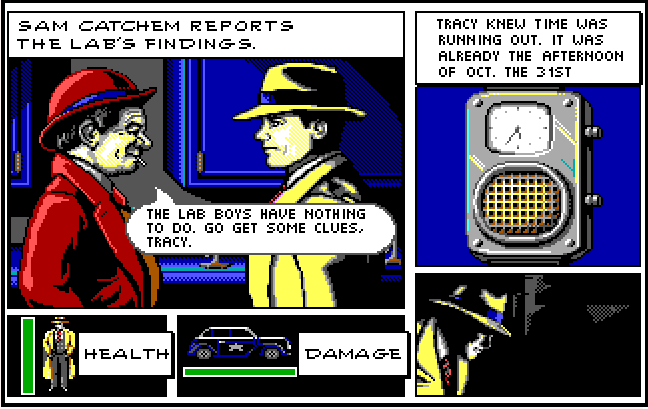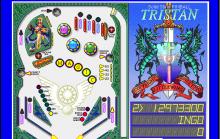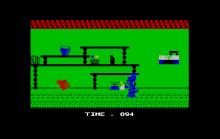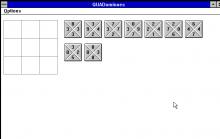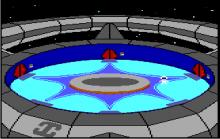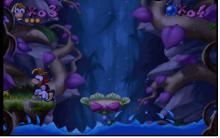Dick Tracy: The Crime-Solving Adventure
Press Keyboard right side: Alt+Enter keys to switch to full screen game play, and Alt+Enter keys to return.
How to play Dick Tracy: The Crime-Solving Adventure
Each game uses different controls, most DOS games use the keyboard arrows. Some will use the mouse.
Dick Tracy: The Crime-Solving Adventure Description
Dick Tracy: The Crime Solving Adventure, for Amiga and DOS, developed by Distinctive Software and also published by Walt Disney Computer Software.
Cheats/Hints/Walkthroughs for Dick Tracy: The Crime-Solving Adventure
DICK TRACY: THE CRIME-SOLVING ADVENTURE MANUAL
Tracy--
Good to have you back from vacation. I hope you got that itch for
sun and sand out of your trousers, because right now you're about as
far as you can get from paradise.
Here's the dirt: While you were gone, the thugs in the city put their
muscles and guns together to create the biggest criminal empire I've
ever seen. The usual mugs-- Flattop, Pruneface, Itchy, Shoulders,
Influence, Numbers, and the rest of them troublemakers-- are no longer
small- time punks running their own shows. They're now carrying out
orders of arson, murder, robbery, extortion, kidnapping, and
counterfeiting in a crime racket that's like one big, unbreakable
machine.
I'm pretty sure that Lips Manlis is calling the shots. Now you know
and I know that Lips Manlis is as crooked as a drunk jaybird, but he's
usually just playing the role of a loudmouth racketeer in a penguin
suit. He's smart, but I don't think he's smart enough to pull off
something this organized. My good Irish guts tell me that Big Boy
Caprice has got his dirty mitts all over this one. I'm sure he's
sitting behind some fancy-schmancy desk at the Club Ritz barking at
Lips Manlis, who then takes it out to his thugs.
You'll have to work fast to stop Big Boy, but getting the goods on
him won't be easy. I hate to admit this, but he's too clever to let
himself be directly linked to any crime. The only way to dismantle
his operation is piece by piece. We've got to arrest enough of them
nickel-and-dime hoods to lure Big Boy into making a crucial mistake.
Sam Catchem and Pat Patton will be working with you at Police
Headquarters--you know you can always count on them for help. About all
I can tell you right now is to get back on the streets: look for clues,
talk to your informants, drop in on friends if you need to--just get out
there and start putting those pieces together.
Attached is the Detective Procedure Handbook which was updated last
week. You know I think you're an ace detective, but I'm asking you to
review it so you don't make any procedural errors. Remember when
Numbers' counterfeiting case was botched? Numbers got off without a
wrinkle and that unlucky detective now investigates expired parking
meters. A mistake can cost us a case--and the more we lose, the more
these two-bit mugs win.
Again, welcome back. Now let's get the grease off the streets!
Chief B.
lh-cb
|Page 1|
Detective Procedure Handbook
Section 1: Crime Case Assignment Page 2
1.1 Case Load
1.2 Criteria for Promotion
1.3 Headquarter Support Staff
1.3a Crime Lab
1.3b Squad Car
1.3c Squad Room
1.3d Rogues' Gallery
1.4 Criminal File
1.5 Crime File
Section 2: Law Enforcement Equipment Page 3
2.1 Two-Way Wrist Radio
2.2 Health Meter
2.3 Squad Car
2.4 Bugs
Section 3: Criminal Interface Procedures Page 5
3.1 Personality Variations
3.2 Vehicle Pursuit
3.3 Suspect Confrontation
Section 4: Evidence Acquisition Page 6
4.1 Questioning Victims
4.2 Gathering Physical Evidence
4.3 Tailing a Criminal
Section 5: Arrest Procedures Page 7
5.1 Questioning Victims
5.2 Arrests
5.3 Crime in Progress
|Page 2|
Section 1: Crime Case Assignment
1.1 Case Load: Regardless of what crimes are on the books, a detective
will be assigned to only one case at a time. A detective must
solve a case before he will be assigned a new one.
1.2 Criteria for Promotion: Solving a case by arresting the correct
criminal without violating established procedures is criteria
for promotion. Ranks within the investigative divisions are
Detective Junior Grade, Detective, Detective First Class, and
Chief of Detectives. The following violations may result in
demotion: 1) Arresting the wrong person, 2) Not acquiring
sufficient evidence to support an arrest, and 3) Repeated stays in
the hospital.
1.3 Headquarters Support Staff: From Police Headquarters a detective
of any rank has complete access to the Crime Lab, Squad Room,
Squad Car, and Rogues' Gallery.
1.3a Crime Lab: Sam Catchem supervises the crime lab. All
evidence discovered in the field will be analyzed by the
lab. Catchem personally reviews all findings with each
detective before storing the results in the Crime File.
1.3b Squad Car: See Section 2.3 for proper squad car checkout
procedures.
1.3c Rogues' Gallery: The Rogues' Gallery allows access to two
important files: the Criminal File and the Crime File. The
Criminal File (Section 1.4) contains rap sheets on known
criminals. The Crime File (Section 1.5) details the crime
a detective is currently assigned to investigate.
|Page 3|
1.4 Criminal File: The Rogues's Gallery displays a group of criminals
currently under investigation. To review a criminal's records,
position his mug shot under the magnifying glass; the criminal's
rap sheet automatically opens to accompany his photo.
Sam Catchem updates the Rogues' Gallery as necessary. He will
remove Criminal Files of those who have been arrested or dismissed
as suspects and will add those who warrant investigation.
All evidence collected on a criminal and any clues retrieved from
his hideout is recorded into his Criminal File.
1.5 Crime File: The Crime File contains details on the type of crime
that occurred, the address at which it took place, and the time
and date it was suspected that the crime was executed. Also stored
in the Crime File are clues from the crime scene and evidence from
informants and witnesses.
Section 2: Law Enforcement Equipment
2.1 Two-Way Wrist Radio: One of the most important advances to law
enforcement in recent years has been a invention of the two-way
wrist radio. Specially developed by Smith Industries, the two-way
wrist radio allows a detective to remain in constant contact with
Headquarters, so he can be immediately notified when a crime is
reported.
The two-way wrist radio also alerts a detective to any activity that
his bugs pick up. A well-placed bug can alert a detective to a crime
that is about to occur.
2.2 Health Meter: The Health Meter is a new piece of required equipment.
The device, which comes in the form of a small cloth "dot", is
placed behind the ear and is imperceptible to the wearer. The
Health Meter allows Headquarters to monitor a detective's overall
physical condition. The department will not allow a detective to
remain on the streets if his health is perilously drained.
These things have been shown to adversely affect health: falls,
gun shots, sewer water, and collisions with objects (while on foot).
As a detective's health deteriorates, the Health Meter changes from
green to red.
If the Health Meter runs out, a detective is required to check into
the hospital to recuperate, after which he will be returned to
Headquarters. Because repeated trips to the hospital suggest
inattention to personal safety, a detective may be demoted for
chronic trips to the hospital.
|Page 4|
A Health Meter does not need to be completely red to adversely affect
performance; when it is predominately red, a detective's performance
will begin to suffer. If a detective is in pursuit of a criminal, he
may not have enough energy required to sustain the chase. The
department strongly recommends that each detective voluntarily submit
himself to a rest program when necessary.
Tracy
I know two things that should keep you in top shape: Tess & Mike's
Diner. If your gal is as good with the first aid as she is with
meatloaf, she can patchup all your scuffs. And I know you'll find
this hard to believe- a bowl of chili from Mike's Diner could put the
shine back on your shoes. Sometimes a little break with a cup of
joe and gut-sticking chili is all you need. In case you haven't
heard, the diner moved into a bigger joint on 9th. Don't go hanging
around either too often-bad for the heart. Dames make it too fast,
chili makes it burn.
Chief B.
2.3 Squad Car: A the beginning of a shift, each detective is assigned
a clean squad car from the garage.
Like a detective's Health Meter, each squad car has a Damage Meter.
As a squad car receives damage, the Damage Meter changes from green
to red. The more distressed a squad car is, the worst it will
perform. Three actions have accounted for the largest percentage of
squad car damage: bumping pedestrians, striking other cars, and
receiving gunfire from criminals.
The state of a vehicle is critical during pursuit-a criminal may
easily outrace a squad car if the vehicle is extensively damaged
and running poorly. The department recommends that a squad car
be returned to a department garage for repairs as often as
necessary. Four department garages are open all day/all night
to service the fleet: 42 1st Street, 200 2nd Street, 16 7th Street,
and 114 10th Street.
|Page 5|
2.4 Bugs: Proper use of bugs provides the detective with a clever way
of staying one jump ahead of the crooks. A detective starts with
three bugs. For each crime that is solved, an additional bug is
rewarded. Bugs can only be planted in a criminal's hideout, but
they can be planted, picked up, and replanted at any time. A
detective is alerted on his two-way wrist radio whenever a bug
detects criminal activity. Bugs Baily is in charge of replanting
a bug whenever a criminal relocates his hideout.
Section 3: Criminal Interface Procedures
3.1 Personality Variations: Criminals come in all shapes, sizes- and
tempers. Some are passive and relatively cooperative when pulled
over. Others are highly agitated and prone to shooting when
confronted.
3.2 Vehicle Pursuit: During vehicular pursuit, the suspect's vehicle
will appear on the squad car monitor. There are three methods of
pulling a suspect over:
1) The first and least confrontational is to turn on the squad car
siren during pursuit. Depending on the suspect's personality
type, he may voluntarily pull over at this point.
2) If the siren is on but the suspect fails to yield, a detective
has the option of shooting out the tires to disable the suspect's
vehicle. As the suspect's car takes damage, his car's Damage
Meter drops from right to left. When the suspect's Damage Meter
turns red, the suspect will be forced to abandon his car.
3) Maneuvering a squad car in front of a suspect's vehicle will force
him to stop.
3.3 Suspect Confrontation: A detective has three options after pulling
over a suspect:
1) Grill the suspect. Criminals react differently to a good, hard
grill. Some buckle under the force of intimidation and will talk,
while others interpret a show of force as an invitation to shoot.
A detective should make his decision based on the number of people
he is confronted with and how the suspect is behaving.
If a gun battle breaks out, the suspect may try to flee. The
suspect may be pursued on foot until he escapes, a detective's
health fails, or the detective apprehends the suspect.
2) Arrest the suspect. Each detective is required to obtain the
proper evidence to validate an arrest. A premature or false
arrest is grounds for demotion. See Section 5: Arrest
Procedures for guidelines.
3) Return to the squad car. If a detective does not believe this
is the proper time to approach the suspect, he may return to
his squad car.
|Page 6|
Section 4: Evidence Acquisition
4.1 Questioning Victims: ALways question victims at the scene of the
crime. They may be able to provide critical information on the
perpetrator.
4.2 Gathering Physical Evidence: Detectives must keep in ind that
criminals can be as negligent as they are malicious. When
investigating crime scenes, hideouts, or other suspicious areas,
take all evidence to the Crime Lab for analysis.
4.3 Tailing A Criminal: A detective may follow any suspect to his
hideout. The opportunity to search a suspect's hideout may yield
solid evidence linking the suspect to the crime. Locating a
criminal's hideout also provides the opportunity for bug planting.
A suspect should not be pursued too closely or he may become alarmed
and attempt to flee.
Tracy
I hear that Breathless Mahoney may be sitting on some information. You
might want to pay her a professional visit. She's at the Club Ritz.
And word is that your little buddy, The Kid, gets around too. The last
report said he was staying somewhere on 5th Street, but he's been
jumpy lately and moves around after someone makes contact with him.
The boys tell me that it's only worth checking in with Kid after you
narrow it down to a couple of thugs; otherwise, the dirt that The Kid
gives you ain't all that firm.
Chief B.
|Page 7|
Section 5: Arrest Procedures
5.1 Prior to Arrest: A good detective uses evidence like height and
hair color to pinpoint the suspect. Using the information in each
criminal's file to dismiss certain suspects while focusing the
investigation on others is the foundation for solid detective work.
Statements from witnesses and informants also bolster a case.
A case is significantly strengthened if evidence can be gathered
from a suspect's hideout. The Crime Lab will analyze the evidence;
if they are able to verify that it came from the scene of the crime,
that becomes damaging evidence linking the suspect to the crime.
Blood, fingerprints, and items from the scene of the crime are
especially incriminating.
5.2 Arrests: Arresting a criminal should only be done after ample evidence
has been gathered to support an arrest. In recent years, numerous
cases have been thrown out due to improper police procedure or lack
of evidence. A premature or false arrest will result in a demotion.
5.3 Crime in Progress: No case is more open and shut than catching a
criminal in the act of committing a crime. If a detective is at
the scene of a crime in progress, he should move in and make the
arrest, Every detective should exercise extreme caution in these
volatile situations. Although not as indisputable as arresting
a criminal in the act of committing a crime, observing a criminal
in the act of committing a crime, observing a criminal fleeing
the scene of a crime is excellent evidence when building a case
against him.
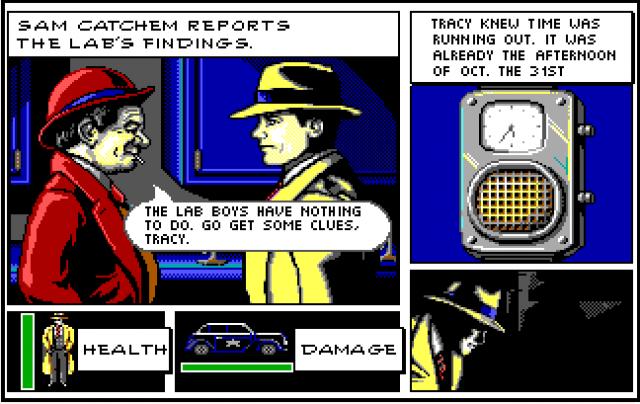
Dick Tracy: The Crime-Solving Adventure - additional information







